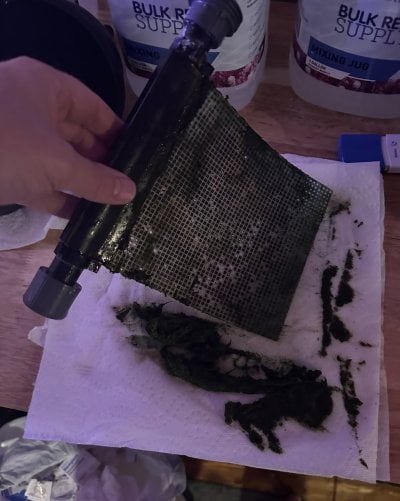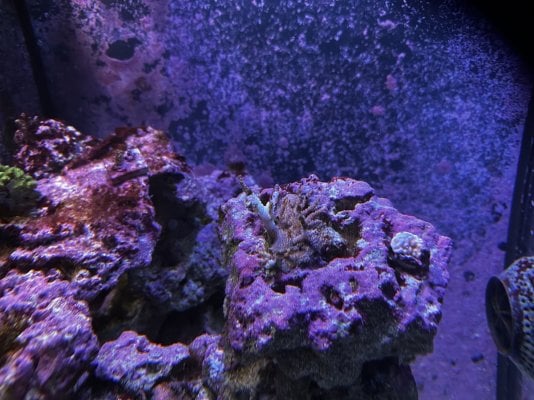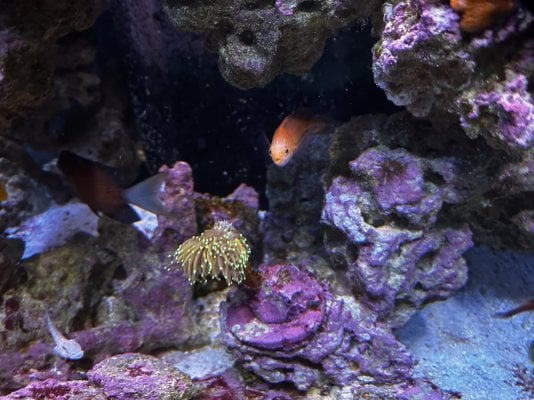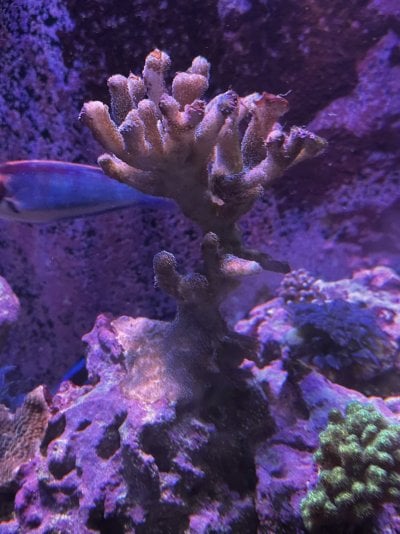Hello All,
I'm looking for help with health on my 240 gallon system. It's been running for 2 and a half years, and I can't seem to have success with my SPS coral (and now appears one of my torches is dying.) I'm attaching some pictures of some SPS coral that appear to be dying. I think my water parameters and flow are fine - which leaves me with my lighting. Would welcome thoughts.
Here are the details on the system:
Display 180 gallon
4 Ecotech XR 30s for light
4 EcoTech MP 40s for flow
Sump 60 gallon
Protein Skimmer
Algae Scrubber
UV Sterilizer
I do weekly maintenance on the system, and am getting great growth from the algae scrubber that I harvest once per week.
First problem I think I could be having is with water quality. But from all the tests I've performed over time - it appears my water quality is where it should be. As to my water changes, I'm using Tropic Marin salt, doing a 30 gallon water change bi-weekly - along with dosing a BRS 3 part solution throughout the week.
As to water parameters, they are as follows:
Kh - Ranges from 8.5 - 9.0 (Hanna Checker)
Ca - 440 (Salifert Test)
Mg - 1,305 (Salifert Test)
NO3 - Ranges from 10 - 17 (Hanna Checker)
PO4 - Ranges from .03-.07 (Hanna Checker)
I've also done ICP tests, and everything was looking fine with some trace elements being a little low - though I pulled the water right before I performed a water change, so I'm thinking trace elements are okay as long as I perform water changes.
Second item I would consider is water flow. With the 4 MP40s, I have them running at 75%, and appears to be fine.
Third item is lighting. A few months back I rented a PAR meter, and brought the lighting from 40% capacity to 55% capacity which brought the PAR to 220-260 on my top layer of rocks. Bottom layer was 150-200. I've read that you need the high PAR for the SPS on top, and even though the lower level LPS don't need a high PAR, being with the high PAR would not necessarily hurt them - though I'm questioning that now with my Torch that's dying off. With the SPS now bleaching / dying off, I'm thinking my PAR is two high, as they were not bleaching / dying before I increased the capacity - they just weren't growing.
I'm kind of at a loss now, not knowing what needs to be done to help my coral. Would welcome everyones thoughts - if there's more detail needed, let me know.




I'm looking for help with health on my 240 gallon system. It's been running for 2 and a half years, and I can't seem to have success with my SPS coral (and now appears one of my torches is dying.) I'm attaching some pictures of some SPS coral that appear to be dying. I think my water parameters and flow are fine - which leaves me with my lighting. Would welcome thoughts.
Here are the details on the system:
Display 180 gallon
4 Ecotech XR 30s for light
4 EcoTech MP 40s for flow
Sump 60 gallon
Protein Skimmer
Algae Scrubber
UV Sterilizer
I do weekly maintenance on the system, and am getting great growth from the algae scrubber that I harvest once per week.
First problem I think I could be having is with water quality. But from all the tests I've performed over time - it appears my water quality is where it should be. As to my water changes, I'm using Tropic Marin salt, doing a 30 gallon water change bi-weekly - along with dosing a BRS 3 part solution throughout the week.
As to water parameters, they are as follows:
Kh - Ranges from 8.5 - 9.0 (Hanna Checker)
Ca - 440 (Salifert Test)
Mg - 1,305 (Salifert Test)
NO3 - Ranges from 10 - 17 (Hanna Checker)
PO4 - Ranges from .03-.07 (Hanna Checker)
I've also done ICP tests, and everything was looking fine with some trace elements being a little low - though I pulled the water right before I performed a water change, so I'm thinking trace elements are okay as long as I perform water changes.
Second item I would consider is water flow. With the 4 MP40s, I have them running at 75%, and appears to be fine.
Third item is lighting. A few months back I rented a PAR meter, and brought the lighting from 40% capacity to 55% capacity which brought the PAR to 220-260 on my top layer of rocks. Bottom layer was 150-200. I've read that you need the high PAR for the SPS on top, and even though the lower level LPS don't need a high PAR, being with the high PAR would not necessarily hurt them - though I'm questioning that now with my Torch that's dying off. With the SPS now bleaching / dying off, I'm thinking my PAR is two high, as they were not bleaching / dying before I increased the capacity - they just weren't growing.
I'm kind of at a loss now, not knowing what needs to be done to help my coral. Would welcome everyones thoughts - if there's more detail needed, let me know.




























